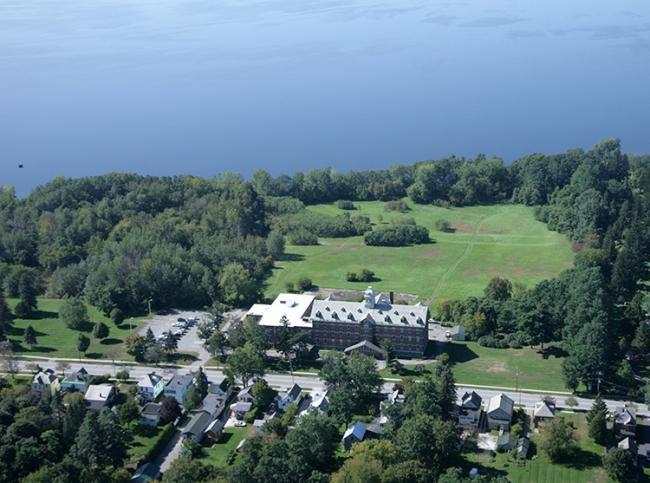Can spiritual regeneration begin as destructive rationality reaches its apex? If so, we’ve come to the end of a cycle that is consistent with the observations of science.
In biological, psychological and social systems, the interactions between elements gradually decrease. The primary state of unity — call it an intuitive or subconscious collective phase — splits into independent causal chains. This "progressive segregation" is accompanied by an increase in complexity, and is followed closely by the mechanization of various functions.
But progressive mechanization results in a loss of the ability to regulate the system as a whole. Different processes continue irrespective on each other, leading to impoverishment and eventual deterioration of performance. At the same time centralization commences. The system becomes more indivisible, and is subordinated under dominant parts. In social systems, at first these are individuals — charismatic leaders, monarchs, presidents and so forth. Later they are structures.
As the next stage — democratization — begins, the arrangement of structures determines process so that certain results are achieved. Eventually, direction through the structure of mechanisms leads to degeneration – known as entropy, or to regeneration – the birth of a new intuitive collective.
 1. In visual terms, the cycle begins with a circle, the symbol for a system, or in religious terms, "being without beginning or end." Within the system are a number of equipotential parts; for example, the human being in a state of nature prior to association through a social contract. In such a state of undifferentiated wholeness, the collective acts as one. Imagine a group of strangers who find themselves in an enclosed space. Before speaking, they are a group of equals, like newborns unaware of the separation between themselves.
1. In visual terms, the cycle begins with a circle, the symbol for a system, or in religious terms, "being without beginning or end." Within the system are a number of equipotential parts; for example, the human being in a state of nature prior to association through a social contract. In such a state of undifferentiated wholeness, the collective acts as one. Imagine a group of strangers who find themselves in an enclosed space. Before speaking, they are a group of equals, like newborns unaware of the separation between themselves. 2. But awareness of self within a situation results in segregation, differentiation of parts, and clustering into subordinate circles. In embryonic development, the organism passes from equipotentiality to a sum of regions that grow independently. In social systems, this is the tribal stage, the point at which permeable boundaries are established. Labor is divided, associations are formed, and specialization of functions emerges. It's still possible to survive outside of association, however, existing on the fringes or moving between groups.
2. But awareness of self within a situation results in segregation, differentiation of parts, and clustering into subordinate circles. In embryonic development, the organism passes from equipotentiality to a sum of regions that grow independently. In social systems, this is the tribal stage, the point at which permeable boundaries are established. Labor is divided, associations are formed, and specialization of functions emerges. It's still possible to survive outside of association, however, existing on the fringes or moving between groups. 3. Increased complexity eventually leads to both mechanization and subordination under dominant parts. The community becomes a city, then a State, and leaders emerge. For social systems this is a time of development, exploration and individuation. Boundaries harden and existence outside now segregated units becomes more difficult. Each group becomes unified and indivisible. At the global level, this is the era of nation-states, technological development, and rivalry between increasingly rigid systems. Those who choose to live outside the society of their birth are seen as eccentrics, hermits, or outsiders. Within each society, despite technological innovations providing the illusion of omniscience, individuals can see less and less of the whole.
3. Increased complexity eventually leads to both mechanization and subordination under dominant parts. The community becomes a city, then a State, and leaders emerge. For social systems this is a time of development, exploration and individuation. Boundaries harden and existence outside now segregated units becomes more difficult. Each group becomes unified and indivisible. At the global level, this is the era of nation-states, technological development, and rivalry between increasingly rigid systems. Those who choose to live outside the society of their birth are seen as eccentrics, hermits, or outsiders. Within each society, despite technological innovations providing the illusion of omniscience, individuals can see less and less of the whole.
4. The last stage begins with democratization, the embrace of dictators and an increased reliance on structures that have been put in place during the earlier stages. The need for certain products and outcomes is assumed, and the demands of structures require a decrease in equifinality as the basis for regulation. In other words, rules can rarely be broken, except by elites, since maintenance of the system requires general discipline and obedience.
Democratization also diffuses dominant leadership values to the masses, who surrender the final remnants of sovereignty in return for individual and collective security. Structure becomes independent of human control, and is unknown as a whole.
As this period of progressive autonomy reaches its climax, mechanization leads to a further loss of ability to effectively regulate. In response, the structure expands its scope to include virtually all sub-units. It has become almost impossible to survive outside this fully rigidified system. Total systemic interdependence has turned participation into a requirement. This stage also emphasizes pragmatism and triage. Unnecessary parts — those that don't adequately contribute to the whole — are discarded. The "spaceship" becomes a lifeboat in which the main requirement is functionality within structural limits, usually defined in purely material terms.
At this stage in the evolution of human society, with inequality, social impoverishment, ecological damage, and violence reaching epic proportions, the structures built to hold back chaos have become suffocating and intolerable for the many. The Great Whale, the bureaucratic way of life, has swallowed almost everyone, and is in the process of making a hell of Earth.
On the other hand, it also is beginning to create space for the emergence of a form of intuitive consciousness, a return to whole behaviors. In other words, there is time for “rational” beings to become what they are not, moving from routines and specialist strategies to ideals and generalist plans. Arrogant dragons can turn into something other than a herd of rhinoceros if the creative in us gives way to the receptive.
Humanity confronts an existential choice: extinction or rebirth. Either way, we will ultimately return to the beginning. Considering that, arrogant dragons would be wise to repent.
Next: Reframing Reality
To read other chapters, go to Prisoners of the Real: An Odyssey































No comments:
Post a Comment